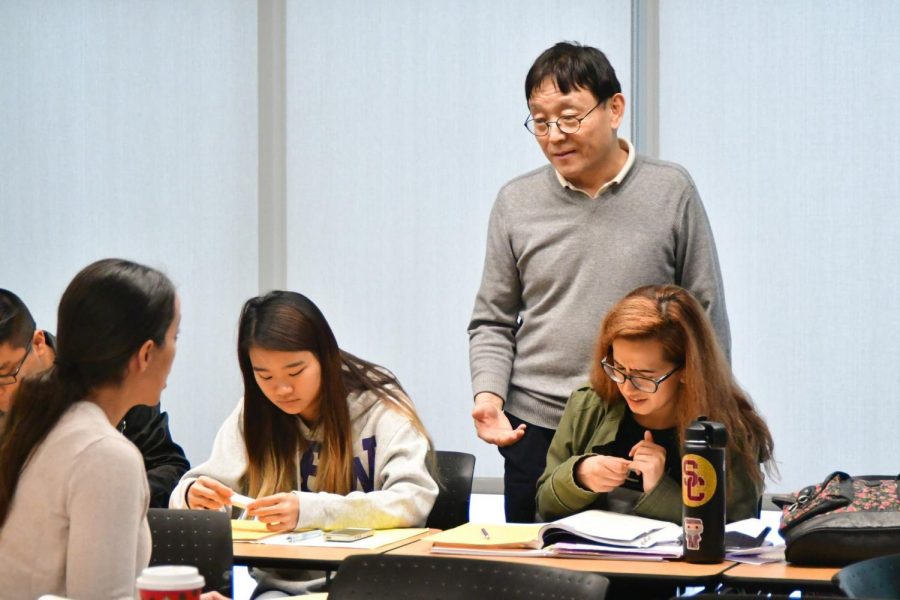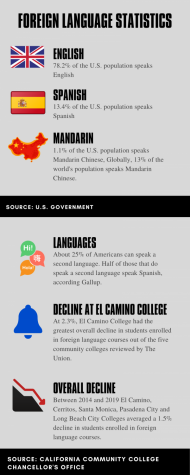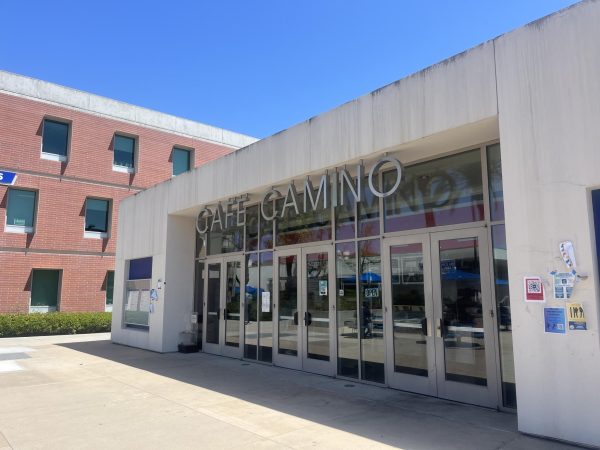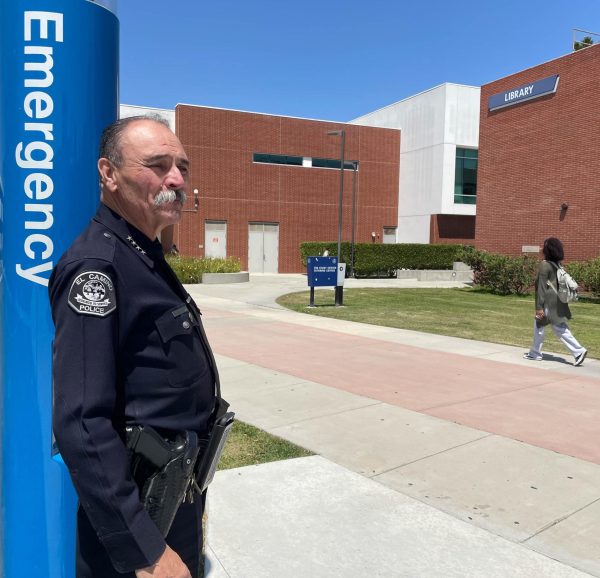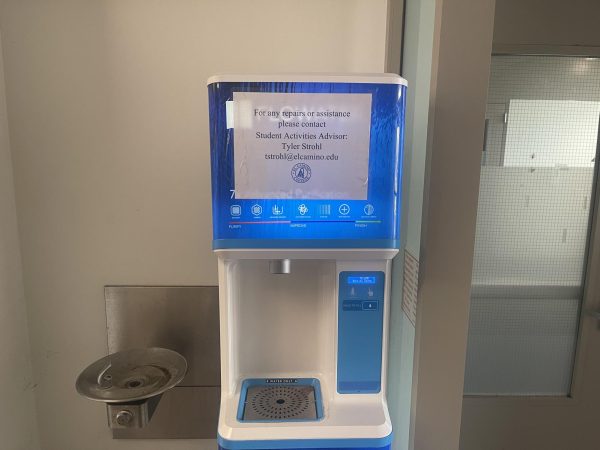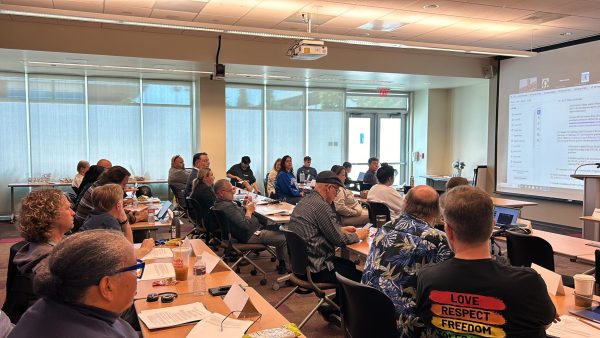Foreign language courses experience decline in enrollment
Chinese and Japanese language professor David Shan, center, helps El Camino College students, left to right, Danielle Boyer, 37, Megan Lin, 19, David and Angela Estrada, 24, with their assignment during their Chinese 2 class Tuesday, Dec. 3. Shan believes that learning a new language is one of the most valuable skills a student can develop. Rosemary Montalvo/The Union
He can see into the future.
Oftentimes his day begins at 4:30 a.m., where he can study among the silence for his Mandarin exams before his two children wake up for school.
Eden Warner is a 56-year-old UCLA business school graduate, businessperson, former Fandango chief financial officer, technology entrepreneur and El Camino College student.
At 6 a.m., he packs his children’s lunches, makes sure they are out of bed, then takes them to the bus stop.
With the kids safely on their way to school, Warner returns to his Culver City home to check on his mother. He then prepares materials for an afternoon meeting in West LA with a potential investor for his new mobile marketing company, Treever.
But before going to the meeting, where he is hoping to raise $1.5 million for his new venture, he must pass a 10:30 a.m. Mandarin exam at El Camino College.
Despite bilingualism being a highly sought-after skill in the workforce and the increasing popularity of language learning apps, Warner is part of a shrinking group of Los Angeles area community college students enrolled in foreign language courses.
“I wish I had more time because I am starting a new company, I got two kids, I just moved my mom out a year ago, so I’m taking care of her, so I’m really really busy,” Warner said.
Regardless of his busy schedule, Warner opted to take Mandarin at ECC instead of using an online platform because, “Chinese is tonal” and the various intonations are difficult to understand without human interaction, Warner said.
“When I left my last job I decided that I was going to learn a language; I decided I was going to learn a language that would challenge me,” Warner said. “I decided that I would choose Mandarin.”
During the spring 2019 semester, 1,136 students enrolled in foreign language courses at ECC, the lowest number in five years.

El Camino is not alone.
Los Angeles area community colleges: Cerritos College, Santa Monica College, Pasadena City College Long Beach City College and El Camino College have all experienced a five-year decline in foreign language enrollment according to the California Community Colleges Chancellor’s Office.
Meanwhile, foreign language learning apps like Rosetta Stone, Babbel and Duolingo have steadily gained popularity during the same time.
While Duolingo has amassed a base of almost 30 million monthly users according to its reported figures, its competitor Rosetta Stone expects to add more than 100,000 subscribers in 2019, a 24% increase from the previous year, according to its 2019 second-quarter earnings report.
Out of the five colleges reviewed by The Union, El Camino had both the steepest decline in foreign language enrollment and was the only college that had zero increases during the last five years.
Santa Monica College has experienced the least overall decline in foreign language enrollment of the five colleges reviewed by The Union. From the fall 2014 semester to the spring 2019 semester, SMC had a foreign language enrollment decline of a half percent out of their total student population, whereas El Camino had a 2.3% decline.
“The Cal States no longer require foreign languages before transfer.” ECC Associate Dean of the Humanities Division, Scott Kushigemachi said. “Before, when that was a requirement, [taking a foreign language course] was an easy sell to a student.”
ECC transfer counselor Rosie Miranda tells all her students that the CSU system does not require foreign language credits to transfer, but she doesn’t think the CSU policy explains the recent enrollment decline at El Camino.
“They don’t need to take a foreign language [to transfer to CSU], not at all. They also don’t need a foreign language to graduate from a CSU unless their major is somewhere in the languages,” Miranda said.
Santa Monica College department chairman of the modern languages and culture program Toni Trives has been teaching Spanish for more than 30 years and also does not believe that the CSU policy explains the decline.
“The CSU thing is a rumor. It has not impacted foreign language enrollment at SMC,” Trives said.
Though the University of California system does require foreign languages to transfer, many students can have that requirement waved before they ever set foot on a college campus by scoring well enough on their high school foreign language advanced placement (AP) exam, Miranda said.
That was the case for 20-year-old English major Haely Ortiz, “I am not taking foreign language at El Camino because I have an AP score [Spanish] that waves that requirement for the CSU and UC, so I really don’t need to take that here,” Ortiz said.
Regardless of the CSU and UC policy, Santa Monica College has managed to defy the trend of declining foreign language enrollment.
“We’ve had a robust program for many years and have worked hard by offering clubs to promote languages and collaborated with different disciplines to make students aware of languages across disciplines like childhood education, business, health sciences and communication studies,” Trives said.
During the 2019 semester, 1,744 Santa Monica College students were enrolled in a foreign language course out of 28,380 students, 6.1% of the student population. At El Camino College, 1,136 students were enrolled in a foreign language course out of 23,328 students, 4.8% of the student population, according to the California Community College Chancellor’s Office.
Another way that Santa Monica College has been able to retain higher foreign language enrollment compared to their counterparts is through the International and Foreign Language Education Title VI federal education grant they applied for and received in 2016, Trives said.
The Title VI grant is designed to promote foreign language education. It has enabled Santa Monica College to offer study abroad programs focused on language acquisition and to host a speaker series with guests from a variety of professions including: businesspeople, broadcasters, teachers and healthcare professionals, Trivas said.
El Camino College has not applied for the Title VI grant, Kushigemachi said.
“We’ve done things with a similar intent [to Santa Monica College], but it’s not like we have a full grant dedicated to that kind of activity. I think those kinds of resources would be a big asset,” Kushigemachi said.
Chinese and Japanese professor David Shan said he wants to see more promotion of foreign language at ECC.
“I want to see our counselors encourage students to plan for the future in different ways and encourage students to take foreign languages,” Shan said.
“I think we encourage a lot of students to take classes that they may not be comfortable with,” Miranda said. “But at the end of the day, they have the option; they have to decide.”
Another possible explanation for the enrollment decline could be that students who are interested in learning a foreign language are opting to study with software, rather than risk hurting their GPA.
ECC Spanish professor Andrés Moina offered The Union his opinion on language learning technologies.
“Babbel, Rosetta Stone, I know those, Duolingo, they are good but they need a structure because for me, most of those apps are for people who already know, already have a background, and who need a foreign language to travel, survive, and communicate with people, but not the academic setting,” Moina said.
For students interested in language learning that are using software instead of taking classes, Moina said that apps and other programs are not a sufficient substitute to the classroom and human conversation.
“For foreign languages you need a strong program in all the skills, not just writing and reading, which is pretty much what they can do with open resources [software],” Moina said. “You need speaking, you need listening, exposures to the culture.”
Moina, Shan, Miranda and Kushigemachi all said that the workload of a four-unit foreign language course can be intimidating for students.
“It’s a four-unit class, most of the foreign languages, so then when you add three additional classes, they know that class is going to require additional lab and work,” Miranda said.
Instead of being intimidated by the four-unit course, Shan encourages students to not fear the learning process and to think more broadly about the opportunities that speaking a foreign language can provide in the future.
“You don’t want to only look at your local situation, you want to see the bigger environment,” Shan said. “In the bigger market, foreign language will definitely make the students more marketable.”
It was Warner’s business career and willingness to engage in another culture that originally brought him to China and inspired him to learn Mandarin.
While working in Beijing for the oil company Arco, Warner began to see the value of learning Mandarin, he said.
On exam day at El Camino, the students shuffled into the classroom, exchanging small talk and jokes in Mandarin with their professor, David Shan.
Some of them seemed a little nervous, but not Eden Warner.
He sat in the center row towards the back of the class, reviewing his textbook and handwritten Chinese notes with humble confidence and a wide smile.
Shan said of Warner and his other students dedicated to their foreign language education that, “they can see the future.”
Editors Note: Headline was updated to accurately reflect article on Thursday, Dec. 12, at 9:10 a.m.


